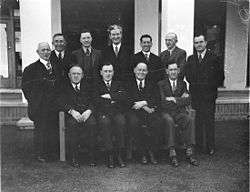Australian Labor Party (NSW)
Australian Labor Party (NSW) | |
|---|---|
| Leader | Jack Lang |
| Founded | 1931 |
| Dissolved | 1936 |

The Australian Labor Party (NSW), commonly known as Lang Labor, was a political group arising from a major breakaway from the Australian Labor Party in New South Wales that operated from 1931 to 1936, when the two groups were reconciled.
History
Following the start of the 1931 Labor split, with the support of the state party, the Labor Premier of New South Wales, Jack Lang, repudiated the Premiers' Plan agreed by a meeting of the Premiers of the Australian states in June 1931 for the economic management of the Great Depression in Australia and announced a policy of foreign debt repudiation, known as the "Lang Plan", and imposed a moratorium on the New South Wales government's overseas loans. This was contrary to the policy of the federal Labor government led by James Scullin. As a result, Lang's supporters, led by Jack Beasley and Eddie Ward, were expelled from the federal Caucus.
This led to a split between the Federal and State executives of the Labor party. In 1931 Lang's supporters in the House of Representatives voted with the United Australia Party Opposition to bring down the Scullin Labor government and force an early election. At the 1931 federal elections, the Lang-controlled New South Wales Branch ran candidates as the Australian Labor Party (New South Wales), but they were generally known as Lang Labor candidates. Supporters of the federal party (led in New South Wales by Ted Theodore and Ben Chifley) were known as Federal Labor candidates.
The elections resulted in a landslide defeat for Federal Labor, but most of the Lang members had ultra-safe working class seats and survived, although Ward was narrowly defeated in East Sydney, before returning at the 1932 East Sydney by-election. Lang Labor won four seats, while nationwide the ALP retained only 14 seats after the loss of 32 seats, and won only three seats in New South Wales. Theodore and Chifley were both defeated ending Theodore's political career.
Lang Labor significantly increased its total vote, and won nine seats, at the 1934 federal election, which saw the ALP win only one seat in New South Wales (Newcastle).
In September 1935, John Curtin succeeded Scullin as Federal Labor leader and in February 1936 he brought about a reconciliation with the New South Wales Branch, resulting in Labor running as a single party throughout the nation at the 1937 federal election. Though Labor remained in opposition after the election, the party's competitiveness was restored with a large increase to their vote and seats held, becoming the largest single party in the House of Representatives on both votes and seats, and successfully positioning the party to form government a year after the 1940 federal election. Furthermore the ALP would enjoy their greatest House of Representatives victory both in terms of proportion of seats and their strongest national two-party vote at the 1943 federal election and additionally their first successful federal re-election attempt at the 1946 federal election.
References
Bibliography
- Lang, J. T. (1970). The Turbulent Years, Alpha Books
- McMullin, Ross (1991). The Light on the Hill: The Australian Labor Party 1891–1991, OUP